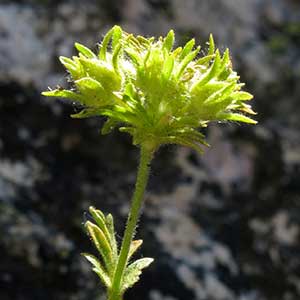Ivesia argyrocoma
Ivesia longibracteata
silver-hair ivesia, silverhair mousetail
Castle Crags ivesia, longbract mousetail
ascending to erect, 0.3–1.2 dm.
weakly planar to loosely ± cylindric, (0.5–)2–4(–6) cm; sheathing base glandular abaxially, otherwise glabrous;
petiole 0.5–2 cm, hairs 0.2–1 mm;
leaflets 5–6 per side, 2–6 mm, ± short-hirsute, glandular-puberulent, lobes 2–7, oblanceolate to spatulate or obovate, apex not setose.
1–3, not paired.
3–14-flowered, 1–2.5 cm diam.;
glomerules 1.
1.5–6 mm.
8–10 mm diam.;
epicalyx bractlets linear to narrowly lanceolate or elliptic, 2.5–5 mm, longer than sepals;
hypanthium shallowly cupulate, 0.5–1 × 2–3 mm;
sepals 1.5–2.5 mm, ± acute;
petals pale yellow, linear to narrowly oblanceolate, 1.5–2.5 mm;
stamens 5, filaments 0.7–1.3 mm, anthers yellow, 0.5–0.8 mm;
carpels 6–11, styles 1–1.5 mm.
cream to light tan, 1.2–1.5 mm.
Ivesia argyrocoma
Ivesia longibracteata
Varieties 2 (1 in the flora).
Plants from the central Sierra San Pedro Mártir in northern Baja California belong to var. moranii Ertter & Reveal, which may be distinguished by its compact stature (to 0.5 dm), densely villous basal stipules 2–4 mm, decumbent stems 2–7 cm that are stipitate-glandular under the villous indumentum, and solitary, loosely congested cyme. The petals are oblanceolate to narrowly obovate and 2.5–3.5 mm. The grayish, faintly mottled achenes are 1.3–2 mm.
(Discussion copyrighted by Flora of North America; reprinted with permission.)
Of conservation concern.
Ivesia longibracteata is known only from the Castle Crags area of Shasta County. The epithet alludes to a diagnostic characteristic unique in the genus: the epicalyx bractlets are longer than the sepals. The plants grow on vertical rock faces, a habitat more characteristic of sect. Setosae; however, the stems are ascending to erect and do not form hanging clumps, and the pedicels are not curved in fruit.
(Discussion copyrighted by Flora of North America; reprinted with permission.)


